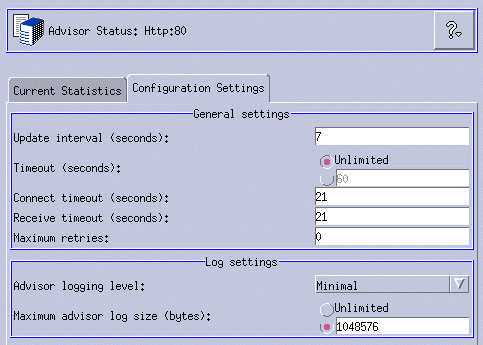Load Balancer Advisor
To display advisor settings, select Advisor: Protocol Port in the tree view, then click Configuration settings in the right pane. This displays the advisor settings...

Figure 19-11 Advisor settings
The following parameters have an impact on performance:
- Update interval: Set this value to control how often the advisor will query the servers for information.
- Timeout: This is the timeout in seconds at which the advisor waits before reporting that a receive from a server fails.
- Connect timeout: Set how long an advisor waits before reporting that a connect to a server for a particular port on a server (a service) fails.
To obtain the fastest failed-server detection, set the advisor connect and receive time outs to the smallest value (one second), and set the advisor and manager interval time to the smallest value (one second). However, if your environment experiences a moderate to high volume of traffic such that server response time increases, be careful not to set the connect timeout and receive timeout values too small, or the advisor may prematurely mark a busy server as failed.
- Receive timeout: Set this to control how long an advisor waits before reporting that a receive from a particular port on a server (a service) fails.
- Maximum retries: Advisors have the ability to retry a connection before marking a server down. The advisor will not mark a server down until the server query has failed the number of retries plus 1. While IBM recommends in Load Balancer Administration Guide, GC31-6858, that the retry value should be no larger than three, IBM recommends setting it to one or even to zero, if your network is stable. If you choose to set it to zero, you should not send TCP resets for the port (see 19.2.4, Port).
- Logging level and maximum log size: In your production system, keep the logging level low and limit the log size to minimize runtime file system access. See Maintain Load Balancer logs, for information about maintaining log files.
| xxxx |